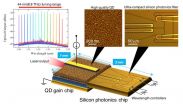(Press-News.org) The impact of scary TV on children's wellbeing has been overstated, according to University of Sussex psychologists.
While research has shown that a small minority of children can have extreme reactions to a scary programme or film, the researchers found that, overall, children show very little sign of increased anxiety, fear, sadness or sleep problems.
University of Sussex research student, Laura Pearce, and Andy Field, Professor of Child Psychopathology at the University, reviewed all research into the topic carried out over the past 25 years.
Their findings, published in the journal Human Communication Research, suggest that, in general, children are fairly resilient to the scary things that they might see on TV.
Professor Field said: "Across studies, scary TV had an impact on children's wellbeing but it was fairly small on average, suggesting that most children are not affected very much at all."
Children spend a lot of time watching TV - in the UK, 4-9-year-olds watch an average of 17 hours and 34 minutes per week, and 10-15-year-olds watch 16 hours and 31 minutes, according to Ofcom.
Meanwhile, fear and anxiety among children and teenagers is on the rise - children in the 1980s reported higher levels of anxiety than psychiatric patients in the 1950s, and these increases have continued to the present day.
Professor Field suggests it is too simplistic to place all the blame for this rise on increased exposure to media.
He said: "We need to do more research into why particular children can be severely affected by particular content on TV. What is it about the media or about those individuals that causes this reaction? There is good reason to believe, for example, that already anxious and/or introverted children might be less resilient to scary content.
"Once we know why certain children are more affected by what they watch than others, we can give more specific and useful advice to parents, rather than assuming that all scary TV is bad for all children, which this analysis shows is not the case."
The researchers also noted that TV guidelines focus on violent content at the expense of non-violent but frightening content - such as worrying news reports or content depicting psychological stress or phobias.
Professor Field added: "Although at the group level the effect of scary TV on children's anxiety is small, it is nevertheless present. This finding has implications for policy-makers because TV guidelines focus on violence but, for some children, scariness will matter and TV can be scary without being violent."
INFORMATION:
Notes for editors
University of Sussex press office: James Hakner and Jacqui Bealing - 01273 678888, press@sussex.ac.uk
'The Impact of "Scary" TV and Film on Children's Internalizing Emotions: A Meta-Analysis' is published now in the journal Human Communication Research.
A scientific group from the Center for RNA Research within the Institute for Basic Science (IBS) and School of Biological Sciences in Seoul National University has reported an insightful molecular mechanism of how Microprocessor, the DROSHA-DGCR8 complex, precisely determines cleavage sites on miRNA-containing primary transcripts allowing faithful initiation of microRNA biogenesis.
The group's findings, published in Cell on 28th May as Advance Online Publication, not only reveal the function of each part of human Microprocessor, but also outline future work on the molecular ...
Bariatric surgery does not only benefit the health of patients who undergo this weight loss procedure. It also leads to greater intimacy between them and their life partners, and adds a spark to their sex life. It's all in all a shared journey that brings partners closer together, says Mary Lisa Pories of East Carolina University in the US, lead author of a study providing insights into the experience of couples after one of the partners underwent weight loss surgery. The findings are published in Springer's journal Obesity Surgery.
Bariatric surgery is the most effective ...
SALT LAKE CITY - Intermountain Healthcare is one of 150 organizations in the nation that was invited to the White House to help develop national policy to address the growing problem of the overuse of antibiotics.
Intermountain has been studying this issue extensively for the past several years and is one the of leading healthcare organizations in the United States to research best practices to help curb the inappropriate use of antibiotics, which is contributing to the growing problem of resistant bacteria.
Intermountain will participate in a one-day antibiotic stewardship ...
BOSTON - A new study from researchers at Beth Israel Deaconess Medical Center (BIDMC) suggests that risk factors for readmission change significantly over the course of the 30 days following hospital discharge. Thirty-day hospital readmission rates have become a federal quality metric intended to reflect inpatient quality of care and unnecessary health care utilization.
Published today in the Annals of Internal Medicine, the research suggests that two distinct 8-day and 30-day readmission rates would serve as better inpatient quality measurements and would better inform ...
The scientific team, from the Institute for Basic Science (IBS) and Seoul National University, has developed an ultra-thin wearable quantum dot light emitting diodes (QLEDs). The electronic tattoo is based on current quantum dot light emitting diode (QLED) technology. Colloidal quantum dot (QLED's) have attracted great attention as next generation displays. The quantum dots (QDs) have unique properties such as the color tunability, photo/air stability, and are printability on various substrates. The device is paper thin and can be applied to human skin like a sticker.
The ...
To arrange for an interview with a researcher, please contact the Communications staff member identified at the end of each tip. For more information on ORNL and its research and development activities, please refer to one of our media contacts. If you have a general media-related question or comment, you can send it to news@ornl.gov.
SOLAR - Suitability mapping ...
Using remote sensing data, researchers can efficiently determine optimum sites for solar power plants, according to a study led by Olufemi Omitaomu of Oak Ridge National Laboratory. With the target of solar ...
University of Adelaide researchers have discovered cerebral palsy has an even stronger genetic cause than previously thought, leading them to call for an end to unnecessary caesareans and arbitrary litigation against obstetric staff.
In an authoritative review published in the American Journal of Obstetrics & Gynecology, members of the Australian Cerebral Palsy Research Group, based at the University of Adelaide's Robinson Research Institute, argue that up to 45% of cerebral palsy cases can have genetic causes.
This builds on research published in February this year ...
A study of marine mammals and other protected species finds that several once endangered species, including the iconic humpback whale, the northern elephant seal and green sea turtles, have recovered and are repopulating their former ranges.
The research, published in the June edition of Trends in Ecology and Evolution, suggests that some species, including humpback whales, have reached population levels that may warrant removal from endangered species lists.
But returning species, which defy global patterns of biodiversity loss, create an urgent new challenge for policymakers ...
Researchers at Tohoku University and the National Institute of Information and Communications Technology (NICT) in Japan, have developed
a novel ultra-compact heterogeneous wavelength tunable laser diode. The heterogeneous laser diode was realized through a combination
of silicon photonics and quantum-dot (QD) technology, and demonstrates a wide-range tuning-operation.
The researchers presented their work at a Conference on Lasers and Electro-Optics (CLEO) in San Jose, California, on May 13. The related
paper was also be published in Applied Physics Express ...
A research group at Tohoku University has succeeded in fabricating an atomically thin, high-temperature superconductor film with a superconducting transition temperature (Tc) of up to 60 K (-213°C). The team, led by Prof. Takashi Takahashi (WPI-AIMR) and Asst. Prof. Kosuke Nakayama (Dept. of Physics), also established the method to control/tune the Tc.
This finding not only provides an ideal platform for investigating the mechanism of superconductivity in the two-dimensional system, but also paves the way for the development of next-generation nano-scale superconducting ...


